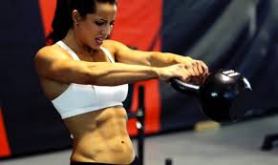It’s fast become the exercise that everyone wants to do. Girls, guys, big people and small folk. The move that is said to work every muscle in your body. You see people walk up and down that gym floor passing the kettlebell rack and thinking hmmmmm…how hard can it be? Looks straight forward enough. Just did a random search for the kettlebell swing on Youtube and it yielded 77,000 results. I then proceeded to search for a video with atrocious swinging and I actually struggled to do so. However, it wasn’t too long before I found one. Better still found a proper WTF image of a bad swing. Check it out:
https://www.youtube.com/watch?v=A4Mkj0ocem4
So today, (or Saturday 3rd August) I attended a kettlebell masterclass with Steve Cotter. All I can say is WOW, a true athlete; if only I had half of his ability. This was one of the toughest training sessions I had attended and the combination of technical application and physical exertion actually had me emotionally drained forgetting that I was in the room with a true legend and beginning to hate kettlebells. Still, it is just as well that through my training with another legend in Scott Sonnon that I am confident I can break down the movement in my head and work on taking small steps at a time towards mastery.
Anyway, this post is specifically about the swing. Steve’s opening lines in the seminar were about how there are different techniques and he believed there were merits to all of them. Indeed, apart from the atrocious example above I have probably performed four different methods of this exercise which are as follows:
- The squat swing: This is ketttlebell heresy to a lot of ‘kettlebell gurus’. It is the technique that most people do when first lifting the bell. You assume it must be some sort of squat and front raise. The likelihood is that most kettlebell classes deploy this method. Certainly it is easy to teach as most people already know how to squat (ish). Interestingly though, one renowned coach actually applies the squat mechanic to the exercise, namely Brent Brookbush. He believes that it is good for athletes to improve their vertical displacement of force. Check his video out
https://www.youtube.com/watch?v=dGKEqYRIS_8
What this means for me is that if a client just finds the ‘true-styles’ too demanding and all they want is a workout I will just give them this technique. Heck, as long as the back is straight it is safe and will get the heart rate up so who cares. My only worry is the indignation of those that only know the ‘proper’ method and are stubborn enough to abhor anything else.
- Hard Style: This is the technique that most people will use after decent training. It needs more coaching as it applies the deadlift mechanic to the swing where the force is more horizontally displaced. It’s about transmitting maximum power to every swing. It looks close to the method I learnt from one of my original trainers Jon Mills. Check out his promo video
https://www.youtube.com/watch?v=pV3DnEU6mOI
Jon is part of the team behind a new Gym App called Gym Chum. Apps are a great way to structure your workouts and stick to something coherent so have a play. www.gymchum.com
I said that this style is a bit like the true ‘Hard Style’ epitomised by the RKC brand of kettlebell training. The only slight difference is the slap down from shoulder height you will see in this video.
https://www.youtube.com/watch?v=vek9BSHFo1c
The amazing throwing coach Dan John also looks as if he is teaching the same technique in his own funny way here:
https://www.youtube.com/watch?v=tVEReOq5Jgs
The idea is that we have maximum load both going up and down by slapping the bell down. Another way of doing this is the banded swing demoed here:
https://www.youtube.com/watch?v=yu0PMzAMudE
- The third method is what we covered in the class called ‘fluid-style’ where we aim to conserve energy. Kettlebell competitions take place and some events are endurance events where you have to keep going for long durations of time. Therefore, you need a method that is fluid and economical. So the movement doesn’t have the greatest inertia but you could carry on for a long time. You also have to make intelligent use of all your available levers so it is very technical. It also applies to one-handed exercises more. Here it is in action
https://www.youtube.com/watch?v=zd0xBJkTp_o
And this is a very brief video of Steve Cotter demonstrating both methods.
https://www.youtube.com/watch?v=QwOp0SrBxuU
And a more detailed article detailing the differences between the hard and fluid styles.
http://www.kettlebellscience.com/a-comparison-of-kettlebell-styles.html
- Then there is the craziest method which still passes as OK and that is the Crossfit style or American style swing where you bring the bell above your head (OMG). This swing is brutal and performed by these dudes
https://www.youtube.com/watch?v=_1ZnChWYTso
So my position is that you can choose anyone of these techniques that you like. With me it is likely to be the hard style but I will perform some protocols with other styles to keep the workout fresh. With every new stimulus your body gets something new to adapt to. The body needs to function and move in a different way and find a specific energy pathway. One thing is for sure though. It is always worth investing in learning kettlebells from someone qualified as it is something that requires that level of skill. You can probably get away with learning other exercises from You Tube but kettlebells are demanding in that sense.
Happy kettlebelling!!



